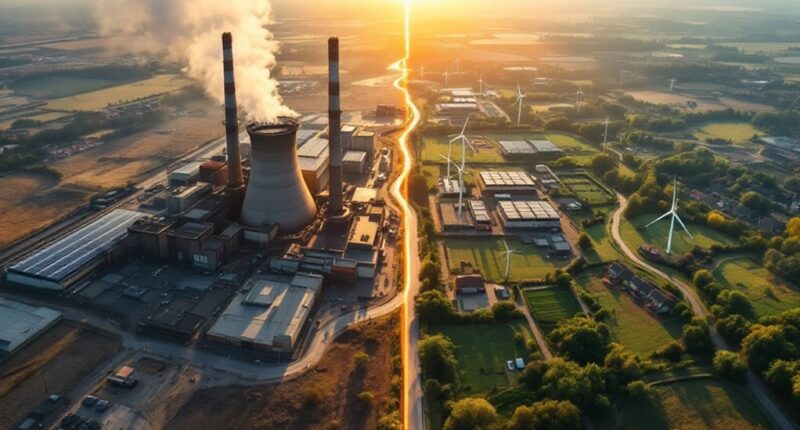A just shift connects environmental progress with social equity, ensuring no communities are left behind during the shift to a sustainable economy. Born from 1970s labor movements and recognized in the Paris Accord, this concept balances job losses in carbon-intensive sectors with the creation of new green opportunities. Success stories from Germany’s Ruhr region and Scotland’s offshore wind initiatives demonstrate that with proper community involvement and investment, regional economies can adapt and thrive. The path forward requires addressing financial challenges while keeping fairness at the center of sustainability’s journey.

The delicate dance between environmental progress and social equity forms the backbone of what experts call “just shift” in sustainability. This concept, born in the labor movements of the 1970s and now recognized in international agreements like the Paris Accord, isn’t just about saving polar bears while coal miners lose their paychecks. It’s about ensuring nobody gets left behind as our economy transforms from carbon-guzzling to carbon-sipping.
Just shift isn’t simply environmental heroism – it’s ensuring no community becomes collateral damage in our climate revolution.
Think of just shift as sustainability’s ethical compass – pointing toward a future where green jobs replace polluting ones, and communities dependent on fossil fuels aren’t simply told, “Tough luck, climate’s changing!” The idea has evolved faster than a Tesla’s acceleration, with the International Labour Organization now providing guidelines that 38% of countries reference in their climate commitments. Businesses are increasingly aligning their operations with sustainable development goals to measure and enhance their contributions to a just transition.
The math paints an optimistic picture: while about 6 million jobs in carbon-intensive sectors might vanish like ice in the Sahara, an estimated 24 million new positions could sprout in the green economy. That’s a net gain that would make any economist’s spreadsheet glow greener than solar-powered neon.
Success stories are popping up like solar panels on suburban rooftops. Germany’s Ruhr region – once married to coal mining – is now flirting successfully with green industries. Spain has invested €250 million in mining communities, helping workers swap coal dust for clean tech. Meanwhile, Scotland’s created a £12 million fund to help oil workers shift from fossil fuel rigs to offshore wind farms – from drilling black gold to harvesting invisible currents.
Of course, challenges remain thornier than a cactus convention. Vulnerable communities often bear disproportionate impacts, resistance bubbles up from fossil-dependent regions, and the €29.4 trillion needed for climate investments won’t materialize without serious commitment. These challenges are compounded by the lack of clarity on just transition practices and insufficient data on potential benefits. Effective transition strategies require meaningful participation from communities that depend on the energy sector for their livelihoods.
The just shift concept reminds us that sustainability isn’t just about saving the planet – it’s about bringing everyone along for the ride. After all, what good is a green future if half the population can’t afford the ticket?
Frequently Asked Questions
Who Pays for Just Transition Programs?
Just changeover programs draw funding from a diverse financial ecosystem.
Government funding comes through dedicated mechanisms like the EU Just Transition Fund (€17.5 billion) and national budget allocations.
Private sector contributions include corporate investments, philanthropic initiatives, and ESG-focused investors.
International financial institutions like the World Bank provide significant support, while innovative financing mechanisms such as carbon pricing revenues, community-controlled funds, and green bonds round out the funding landscape for these socially conscious sustainability shifts.
How Long Does a Just Transition Typically Take?
Just transformations typically span varied timeframes, from as short as 5-10 years to as long as several decades.
Germany’s coal transformation, for example, has extended beyond 50 years. Duration depends on multiple factors including economic complexity, funding availability, political will, workforce skills, and technological pace.
The process unfolds through distinct phases: assessment (6-12 months), strategy development (1-2 years), initial implementation (2-5 years), and long-term execution (5-20+ years).
Effective transformations require both short-term support and long-term planning.
Can Just Transitions Work in Developing Economies?
Just transformations can indeed work in developing economies, though with unique challenges.
Despite limited financial resources and high informal employment, these countries can leverage abundant resources for green technologies and leapfrog directly to cleaner systems.
Success depends on stakeholder engagement, skills development, social protection policies, and international support.
Nigeria’s climate commitments and South Africa’s $8.5B Energy Transformation Partnership demonstrate promising approaches.
The key lies in balancing economic transformation with social equity during the change away from fossil fuels.
What Skills Are Most Valuable During Sustainability Transitions?
During sustainability transformations, a blend of technical and interpersonal skills proves most valuable.
Technical green skills like carbon accounting and renewable energy expertise form the foundation, while soft skills such as stakeholder engagement and systems thinking enable implementation.
Cross-functional competencies in circular economy principles and environmental assessment provide practical application, while leadership abilities in change management and strategic planning help guide organizations through complex sustainability changes.
This skill combination allows professionals to navigate both technical challenges and human dimensions of environmental change.
How Are Just Transition Success Stories Measured?
Success stories in just shifts are measured through a multifaceted approach.
Quantitative indicators track employment creation, economic growth, and emissions reductions, while qualitative assessments capture stakeholder satisfaction and community experiences.
Effective governance frameworks and diverse stakeholder engagement serve as process metrics.
The most compelling measurements combine hard numbers with human narratives—pairing job creation statistics with workers’ testimonials or matching renewable energy adoption rates with community well-being indicators.









